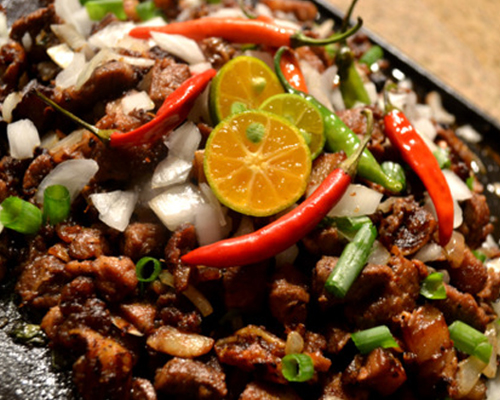8 Signature Kapampangan Dishes that You Should (Really) Try
Nov 8, 2013 • Lorraine Timbol

Nov 8, 2013 • Lorraine Timbol
There are two types of morcon I remember, the beef roulade of my grandmother, that’s thinly sliced beef sirloin stuffed with El Rey’s chorizo de bilbao, Vienna sausage, eggs, carrots and pickles simmered for hours in rich tomato sauce. And then there’s the morcon from Everybody’s Café (similar to the embotido) which I surmise is a combination of ground beef and ground pork, mixed with chorizo de bilbao and all other morcon ingredients, wrapped in sinsal (pork intestinal lining that looks like an artwork) and simmered in a sauce that has lots of the chorizo de bilbao, and perhaps pimenton to add to that flavorful thick sauce.
Tugak is Kapampangan for frogs. The frogs used for batute are farm raised frogs so no worries there, they’re not the poisonous bull frogs you see around. This exotic dish is a must try for the adventurous soul within you. The frogs are stuffed with seasoned ground beef and deep fried. The first time my then six-year-old son saw this, he courageously picked it up, played with the fried frog, let it dance around his plate then ate it with eyes closed.
The pindang kalabaw is cooked in a little water with some cooking oil. When the fat comes out and the meat is tender, cook the meat until it turns reddish brown. Paired with lots of steaming hot rice, tomatoes, and sukang sasa this is heaven on a plate. Pindang Kalabaw is an all-time family favorite and we like it sour not sweet. That only means that the carabao meat was cured longer outside of the refrigerator so as to heighten the sourness rather than the sweetness of the pindang. This is similar to pork tocino which is more commonly available in the market. Actually if pork tocino is made to stay longer outside of a cool place to ferment, the tocino will also turn out a bit sour.
This one is another exotic Kapampangan delicacy. Everybody’s Café is famous for this delectable dish that is not for the squeamish. Some people cringe at the thought of eating and munching on a plate of insects. But Kapampangans make no bones about it. The camaru is cooked adobo style and deep fried with tomatoes and onions. Munch on a plate and you will forever be a turncoat. This is a must try even for the not so brave.
The sisig story began near the old railroad tracks in the city of Angeles in Pampanga. Luciana Cunanan better known as Aling Lucing catapulted the sisig into national sensation status and managed to be included into a list of top 50 delicious Filipino foods. Aling Lucing’s sisig is boiled, grilled and fried before it’s served on a hot sizzling plate. Hers is crunchy the way I like it. Add to that the creamy taste of the combination of chicken liver and pig brains that give you that trancelike sensation after a satisfying meal. For other less creamy crunchy sisig versions, try cracking an egg on top or lace it with a tablespoon of mayonnaise or go all out and just add both for a headier treat.
Balo-balo as Kapampangan’s call it is commonly known as buro. The balo balo is fermented rice with fresh live shrimp suahe, sautéed in garlic and loads of tomatoes. It is best served with fresh mustard leaves (mustasa), grilled talong (eggplant) and grilled or fried hito. Enjoying balo-balo is an acquired taste but once the palate gets enamoured with the sour funny smelling delicacy there’s no turning back.
The best Bringhe I ever tasted was the one made by my grandmother. Unlike other recipes that use pure malagkit (glutinous) rice, hers uses half malagkit rice and half regular rice. This makes for a savory rice dish that pairs superbly with the usual fiesta fare such as chicken pastel or pastel de lengua. The rice combination is cooked in coconut milk and luyang dilaw (turmeric) which is responsible for that yellow green color of the cooked dish. Bringhe is also laden with chicken, topped with boiled eggs and red and green bell peppers, making the dish not just tasty but likewise attractive.
Another delicacy that Pampanga is well known for is taba ng talangka or pure fat from tiny crabs. To describe this as rich in flavor is an understatement. Pure taba ng talangka sautéed in lots of garlic then squeezed with some calamansi or lemon juice mixed with hot steaming rice while eating with ones bare hand is the best way to enjoy this. Another funky way of savoring this is by cooking it with pasta and prawns. If I may suggest try stuffing prawns with taba ng talangka, then top with breadcrumbs and grated cheese and bake a la prawns thermidor. Or cook those huge coconut crabs in taba ng talangka for a double dose of hearty crab fat.
Lorraine Timbol, also known as LT, former culinary consultant for Unilever and EIC of Appetite Magazine is a frustrated actress who managed to get into bit roles at the tender age of 40. She is now comfortably in her element as a freelance food stylist and food writer, teaching Cohen cooking on the side.
Input your search keywords and press Enter.

3 comments